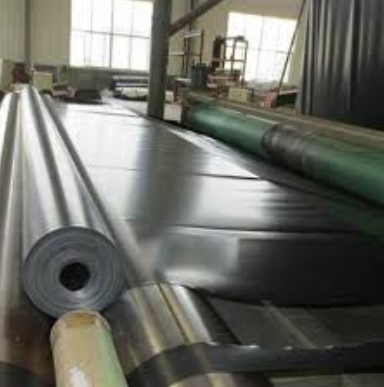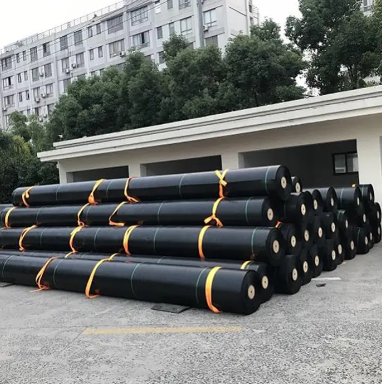- Understanding the Role of Geomembrane Liners in Waste Management
- Innovations in Geomembrane Liners for Water Management
- Geomembrane Liners: A Comprehensive Guide
- The Future of Geomembrane Liners in Civil Engineering
- Geomembrane Liners: Enhancing Landfill Stability
Manager:Alvin Wang
WhatsApp:+62 8983806051
Tel:+86 10-5797-1075
Email:steelwang@okorder.com
Address:3rd Floor, No.2 Building, No.1 Sanlihe Road
Does HDPE geomembrane release toxins?
Commonly, High-Density Polyethylene (HDPE) geomembranes are used in civil engineering, environmental protection and geotechnical applications for their hardiness, pierce inability and resistance to chemicals. However, one may be concerned with the possibility of toxins emanating from hdpe Geomembranes into the natural habitat. This article discusses various factors that influence this phenomenon, processes involved in it as well as effects on health.

Understanding Toxic Release from HDPE Geomembrane
Chemical Composition:
HDPE geomembranes consist of high-density polyethylene which is a thermoplastic polymer produced through ethylene monomer units. It is known for its stability, non-reactivity and inertness making it suitable for chemical resistant and environmentally compatible applications. Typically, HDPE geomembranes incorporate other additives like antioxidants, UV stabilizers and carbon black so as to improve performance and increase durability.
Toxic Substances:
Though not inherently poisonous in themselves, there are concerns that some additives or impurities within geomembrane materials might leach under particular circumstances into surrounding environments. For instance; antioxidants, UV stabilizers or processing aids may contain trace amounts of chemicals that could leach out over time especially when the geomembranes are subjected to water exposure or sunlight besides soil contact.
Factors Influencing Toxin Release
Environmental Conditions:
The release of toxins from HDPE geomembranes depends on environmental factors such as temperature change, humidity variation and pH differences in relation to chemical exposures. Such conditions include higher temperatures; acidic/alkaline environment alongside long term exposure to harsher substances causing faster degradation of the geomembrane materials hence increased rates towards toxin release. Therefore environmental situations play an important role in determining whether toxic substances are released by these High Density Polyethylene (HDPE) membranes.
Exposure Duration:
If HDPE geomembanes come into contact with environmental factors for a short time, they may not release toxins but if the contact period is longer it increases the chances of toxins being released. For instance, geomembranes used in landfills, ponds and reservoirs that are long-term containment practices can be exposed to water, soil, sun and chemicals over a long span hence this exposes them to dangers of toxin release. For proper mitigation of risks associated with toxin release such as these; monitoring geomembrane exposure duration should be done and measures must be put in place.
Chemical Compatibility:
Toxin release potential of HDPE geomembranes highly depends on their compatibility with surrounding substances. While HDPE is resistant to many chemicals some aggressive substances may attack geomembrane material causing degradation or leaching out any possible chemical reactions leading to toxic products. Therefore understanding the chemistry behind development of HDPE geomembranes and its interaction with its surroundings helps in assessing whether there is possibility of releasing toxins.
Mechanisms of Toxin Release
Leaching:
The first mechanism by which toxins are released from HDPE Geomembranes is called leaching where chemicals or additives found in geomembrane materials go into themselves environment around due to passage of time. Chemicals get into the environment either through diffusion, dissolution or desorption depending on the properties exhibited by the constituent elements as well as other environmental factors. Other factors that affect how much leaching occurs include type of polymer composition used, duration for which it has been exposed among others.
Degradation:
Another way in which toxins are released from HDPE Geomembranes is through their wear out known as degradation caused by physical activities like oxidation, hydrolysis or photodegradation which break down polymer chains within the Geomemrane thus releasing degradation by –products or breakdown product into environment . This may occur gradually over years when geomembrane materials degrade.
Implications for Human Health and Environmental Safety
Human Exposure:
The concern is expressed to the possibility of the toxic substances being released into the environment from HDPE geomembranes. The exposure of toxins that may be emitted as a result can put workers, residents or communities nearby at risk. If one breathes in air, drinks water containing them or has any physical contact with such polluted soils, disease conditions will emerge.
Environmental Impact:
Soil, surface water, groundwater and ecosystems might also get contaminated through toxin release from HDPE geomembranes. Wildlife, aquatic organisms and terrestrial ecosystems could be affected by contaminants let loose by geomantegenesis which enter and bind together in the food chain system. What happens after a toxin is released relies on factors like type as well as concentration of pollutants, how sensitive neighboring areas are and how far pollution goes.
Mitigation Strategies
Material Selection:
Selecting geomembrane materials for example HDPE which include fewer additives or impurities reduces the chance of releasing hazardous substances. In order to avoid leaching or degradation-induced toxin release select only those geomembrane materials certified for environmental compatibility and chemical resistance. Consider project-specific requirements, environmental conditions and performance criteria when selecting geomembrane materials.
Environmental Monitoring:
Monitoring environmental conditions can help lead to recognition of the occurrence of toxin release from HDPE geomembranes surrounding air, water soil etc. Regular sampling analysis and testing in various environmental media will help identify emerging risks as well as development of mitigation strategies towards safeguarding human health and safety.
Regulatory Compliance:
Compliance with guidelines regulations set forth by regulatory authorities when installing operating and maintaining geosynthetic liners within the various sites is another way that keeps public health safe while adhering to these principles pertaining to installation procedure followed by regular maintenance procedures for all facilities concerned with liners made out of geotextile like materials used in drainage ditches across pavements along roadsides . These standards should not go beyond established limits related to concentrations found in ambient air, water and soil for them to be considered safe to the people living around such an area. Adherence with regulatory prescriptions helps reduce the chances of toxin release as well as responsible use of HDPE geomembranes in engineering and environmental applications.

Conclusion
In conclusion, HDPE geomembranes are not by themselves toxic but there is potential for the release of toxins from geomembrane materials under certain conditions. The probability and magnitude of toxin release of this kind from HDPE geomembranes depend on several factors that include, among other things, exposure duration, environmental conditions, chemical compatibility and degradation mechanisms. In order to ensure safety in human health and environment when dealing with HDPE geomembranes as used in civil engineering or environmental projects; knowledge about how toxins are released into the surrounding media should be made available; risks should be evaluated; preventive measures must also be adopted for avoidance purposes.
- Previous:What is the weakness of HDPE geomembrane?
- Next:Which is stronger, HDPE geomembrane or UHMW?
-
2024-12-05Geomembrane Liners: A Comprehensive Guide






